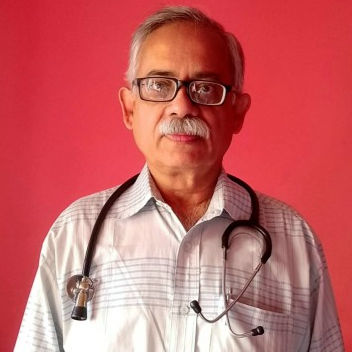Guide to Effects Of Physical Inactivity
Learn about the serious effects of physical inactivity on your health, including increased risk of chronic diseases, weight gain, and mental health issues. Discover practical tips to incorporate more movement into your daily life.

Written by Dr. M L Ezhilarasan
Reviewed by Dr. Shaik Abdul Kalam MD (Physician)
Last updated on 21st Sep, 2025

Introduction
In our modern world of desk jobs, long commutes, and digital entertainment, physical activity has often been squeezed out of our daily routines. Many of us are unaware of the profound and silent toll this sedentary lifestyle takes on our health. The effects of physical inactivity extend far beyond just weight gain; they seep into every system of our body, increasing the risk for chronic diseases, deteriorating mental health, and ultimately shortening lifespans. This isn't about a need for intense athleticism, but rather the critical importance of regular movement. This article will comprehensively break down the multifaceted effects of physical inactivity, from your heart and metabolism to your muscles and mind. We'll explore the science behind the risks and, most importantly, provide actionable strategies to help you break the cycle and reclaim your vitality. Understanding these effects is the first powerful step toward a healthier, more active life.
What Exactly Constitutes a Physically Inactive Lifestyle?
Physical inactivity is defined by the World Health Organization (WHO) as not meeting its recommended levels of physical activity. For adults aged 18-64, this means at least 150-300 minutes of moderate-intensity aerobic activity or 75-150 minutes of vigorous-intensity activity per week, plus muscle-strengthening activities on two or more days. If your routine doesn't hit these benchmarks, you fall into the "insufficiently active" category.
It's crucial to distinguish this from sedentary behavior, which is any waking activity characterized by an energy expenditure of ≤1.5 metabolic equivalents (METs) while in a sitting, reclining, or lying posture. This includes sitting at a desk, watching TV, or scrolling on your phone. You can be physically inactive (not exercising) but not sedentary if you have a job that keeps you on your feet. Conversely, you could meet the weekly exercise quota but still be highly sedentary if you spend the rest of your time sitting. Both states are independently harmful to your health.
A common benchmark for a non-sedentary day is taking 10,000 steps, though some studies suggest even 7,000-8,000 can provide significant benefits for longevity. The key is to avoid prolonged, unbroken periods of sitting.
The Cardiovascular Consequences: Your Heart Under Stress
Your heart is a muscle, and like any muscle, it needs exercise to stay strong. When you are physically inactive, your heart doesn't get the workout it needs, leading to a cascade of problems.
Firstly, inactivity is a primary contributor to hypertension (high blood pressure). Without exercise, your blood vessels become less flexible, forcing your heart to work harder to pump blood. This constant strain damages artery walls over time, making them more susceptible to plaque buildup—a condition known as atherosclerosis. This narrows the arteries and can lead to coronary artery disease, heart attacks, and strokes. Research shows that sedentary individuals have a 20-30% increased risk of death from cardiovascular events.
Furthermore, physical inactivity negatively impacts your blood lipid profile. It lowers levels of HDL ("good") cholesterol, which helps remove LDL ("bad") cholesterol from your arteries. Simultaneously, it can increase levels of triglycerides, a type of fat in your blood. This dangerous combination significantly elevates your risk for atherosclerosis. A study published in the Journal of the American College of Cardiology found that replacing just 30 minutes of sitting with light activity could improve these key cardiovascular biomarkers.
Consult Top Specialists
The Metabolic Meltdown: Blood Sugar and Weight Management
Your body's ability to manage blood sugar (glucose) is critically dependent on muscle activity. Muscles are the largest consumers of glucose in your body. When you are inactive, muscles become less sensitive to insulin, the hormone that tells cells to absorb glucose from the blood. This state, known as insulin resistance, is the primary precursor to Type 2 diabetes.
When cells don't respond to insulin, glucose builds up in the bloodstream, leading to high blood sugar. The pancreas then produces even more insulin to compensate, leading to a vicious cycle that eventually burns out the insulin-producing cells. The CDC states that regular physical activity can cut your risk of developing type 2 diabetes by up to 50%.
This metabolic dysfunction is also a key driver of weight gain and obesity. Without activity, you burn fewer calories. Consistently taking in more calories than you burn leads to weight gain, primarily as visceral fat—the deep abdominal fat that surrounds your organs. Visceral fat is metabolically active, releasing inflammatory chemicals that further worsen insulin resistance and contribute to metabolic syndrome, a cluster of conditions that dramatically increase heart disease, stroke, and diabetes risk.
Musculoskeletal Decline: Weakening the Body's Framework
"If you don't use it, you lose it" is perhaps most literally true for your muscles and bones. Muscle atrophy, the wasting away of muscle tissue, begins surprisingly quickly with inactivity. This age-related loss of muscle mass and strength is known as sarcopenia, and a sedentary lifestyle dramatically accelerates it. Weak muscles contribute to poor balance, a higher risk of falls, and a loss of functional independence.
Similarly, bones are living tissue that require stress to stay strong. Weight-bearing exercises like walking, running, and strength training stimulate bone-forming cells. Without this stimulus, your body leaches calcium from bones, making them weaker, more brittle, and susceptible to osteoporosis and fractures.
Perhaps the most immediately felt effect for many is chronic back pain and joint stiffness. Sitting for long periods, especially with poor posture, puts immense pressure on lumbar spinal discs. It also causes hip flexor muscles to shorten and become tight, while gluteal muscles weaken. This muscular imbalance is a leading cause of lower back pain. Lack of movement also reduces synovial fluid production in joints, leading to stiffness and discomfort.
The Mind-Body Connection: Mental and Cognitive Effects
The impact of a sedentary lifestyle isn't confined to the body; it deeply affects the mind. Numerous studies have established a strong correlation between physical inactivity and an increased risk of depression and anxiety. Exercise naturally boosts endorphins ("feel-good" hormones) like serotonin and dopamine, which improve mood and act as natural stress relievers. Without this release, you may be more vulnerable to low mood and heightened stress responses.
Emerging research also highlights a link to cognitive decline. Exercise increases blood flow to the brain, promoting the growth of new neurons and connections, particularly in the hippocampus—a region vital for memory. A sedentary lifestyle is now considered a modifiable risk factor for dementia and Alzheimer's disease. Regular movement can improve focus, creativity, and overall brain health, helping to keep your mind sharp as you age.
The Hidden Dangers: Cancer Risk and Immune Function
One of the less discussed but equally serious effects of physical inactivity is its link to an increased risk of certain cancers. The American Cancer Society notes that a lack of physical activity is linked to a higher risk of cancers of the bladder, breast, colon, endometrium, esophagus, kidney, lung, and stomach. The mechanisms are complex but are believed to be related to the role exercise plays in regulating hormones like estrogen and insulin, reducing inflammation, and improving immune function.
Speaking of immunity, moderate regular exercise is known to give your immune system a boost by promoting good circulation, which allows immune cells to move through the body more effectively. Conversely, prolonged sedentary periods can lead to a weakened immune system. This may make you more susceptible to common infections like colds and flu, and can even lead to slower healing times.
Breaking the Cycle: Practical Steps to Reverse the Effects
The excellent news is that the damage from physical inactivity is largely reversible. You don't need to run a marathon; you just need to start moving more consistently.
- Incorporate NEAT: Focus on increasing your Non-Exercise Activity Thermogenesis (NEAT)—the calories you burn from daily activities. Take the stairs, walk during phone calls, park farther away, do a five-minute stretch every hour.
- Stand Up: Consider a standing desk or create an improvised one. The simple act of standing engages muscles and burns more calories than sitting.
- Schedule Movement: Set a timer to stand and move for 2-3 minutes every 30 minutes. This breaks the cycle of
prolonged sitting, which is key for metabolic health. - Start Slow: If new to exercise, begin with short, brisk walks. Aim for 10-15 minutes a day and gradually increase.
Activities like swimming or cycling are gentle on the joints. - Find Joy: Choose activities you enjoy—dancing, gardening, hiking. You're more likely to stick with something you find fun.
If you experience persistent pain, dizziness, or other concerning symptoms when starting a new activity, it's crucial to consult a professional. You can book a physical visit to a doctor with Apollo24|7 to get personalized advice and ensure you're exercising safely.
Conclusion: Investing in Movement for a Healthier Tomorrow
The evidence is overwhelming: physical inactivity is a silent public health crisis with far-reaching consequences. It undermines the very foundation of our physical and mental well-being, paving the way for a host of preventable diseases. However, this narrative is not set in stone. Understanding these effects empowers us to make different choices. View movement not as a chore, but as a fundamental investment in your long-term health—a non-negotiable deposit into your future vitality. Every step you take, every stretch you do, and every minute you spend standing is a proactive step toward a stronger heart, a sharper mind, and a more resilient body. Start today, start small, and build a more active life. Your future self will thank you for it.
Consult Top Specialists
Consult Top Specialists

Dr. Rajib Ghose
General Physician/ Internal Medicine Specialist
25 Years • MBBS
East Midnapore
VIVEKANANDA SEBA SADAN, East Midnapore

Dr. Sougata Kumar
General Practitioner
8 Years • MBBS
East Midnapore
VIVEKANANDA SEBA SADAN, East Midnapore

Dr. Abhishek Ranjan
General Practitioner
4 Years • MBBS
Kolkata
VDC Clinic, Kolkata

Dr. Pinaki Mukhopadhyay
General Physician/ Internal Medicine Specialist
32 Years • MBBS
Kolkata
MCR SUPER SPECIALITY POLY CLINIC & PATHOLOGY, Kolkata
(25+ Patients)

Dr. Uddalak Chakraborty
Neurologist
8 Years • MBBS,MD(GENL. MED.),DM(NEUROLOGY)
Kolkata
VDC Clinic, Kolkata
Consult Top Specialists

Dr. Rajib Ghose
General Physician/ Internal Medicine Specialist
25 Years • MBBS
East Midnapore
VIVEKANANDA SEBA SADAN, East Midnapore

Dr. Sougata Kumar
General Practitioner
8 Years • MBBS
East Midnapore
VIVEKANANDA SEBA SADAN, East Midnapore

Dr. Abhishek Ranjan
General Practitioner
4 Years • MBBS
Kolkata
VDC Clinic, Kolkata

Dr. Pinaki Mukhopadhyay
General Physician/ Internal Medicine Specialist
32 Years • MBBS
Kolkata
MCR SUPER SPECIALITY POLY CLINIC & PATHOLOGY, Kolkata
(25+ Patients)

Dr. Uddalak Chakraborty
Neurologist
8 Years • MBBS,MD(GENL. MED.),DM(NEUROLOGY)
Kolkata
VDC Clinic, Kolkata
More articles from General Medical Consultation
Frequently Asked Questions
1. What are the first signs of being too sedentary?
Early signs can include constant low energy, stiffness and achiness (especially in the back and hips), difficulty sleeping, irregular digestion, and 'brain fog' or trouble concentrating.
2. Can the effects of years of inactivity be reversed?
Yes, absolutely. The human body has a remarkable ability to adapt and heal. While some changes may take time and consistency, starting to incorporate regular physical activity can improve cardiovascular health, insulin sensitivity, muscle strength, and mental well-being at any age.
3. I have a desk job. What are the best ways to avoid the risks of prolonged sitting?
Use a standing desk if possible, or set a timer to stand up and stretch for 2-3 minutes every 30 minutes. Take walking meetings, use the bathroom on a different floor, and walk during your lunch break. These small breaks are crucial for mitigating the metabolic risks of prolonged sitting.
4. How does lack of exercise cause weight gain?
It creates a calorie imbalance (consuming more than you burn) and reduces muscle mass, which lowers your resting metabolic rate. It also promotes insulin resistance, which encourages the body to store excess calories as fat, particularly visceral fat.
5. Is walking enough to combat a sedentary lifestyle?
Yes, walking is an excellent and underrated form of exercise. Brisk walking counts as moderate-intensity activity. Aim for at least 30 minutes most days of the week to meet health guidelines and effectively combat the negative effects of physical inactivity.

 Health Benefits.webp)


